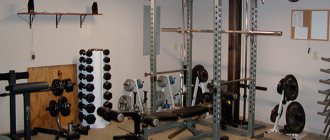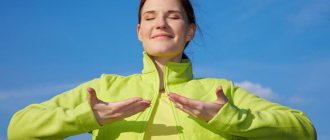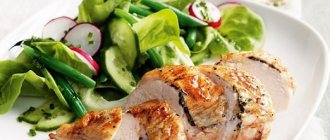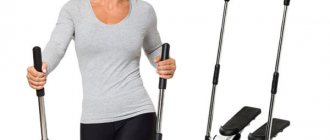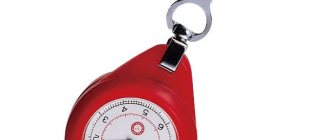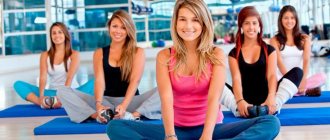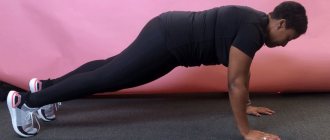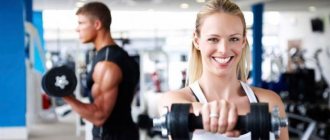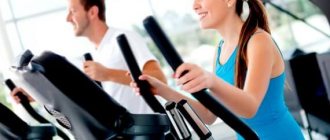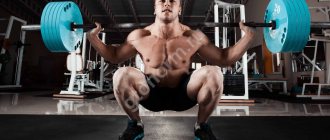With varicose veins, the condition of the venous vessels is disrupted and, as a result of this process, the reverse flow of blood from the extremities to the heart is disrupted. The return of blood is carried out with the additional help of muscle contractions. Due to the fact that the muscles are in constant tone even at rest, normal blood circulation is maintained.
Interestingly, varicose veins only occur in humans. This is due to the fact that when a person is in a standing position, the lower limb veins experience a lot of pressure. In animals it is distributed more evenly.
The main factors that stimulate the development of varicose veins are:
- Hereditary predisposition. It affects the appearance of many pathologies and varicose veins are no exception, but! Heredity is not a death sentence and largely depends on you whether you will develop varicose veins or not.
- Great physical activity. During intense sports, the upper venous vessels begin to deform. They and their components stretch and lose elasticity. The permeability of the veins is disrupted and blood flows freely into those vessels that are located below. Thus, the pressure increases and the process continues as usual.
- Excess weight. Its mechanism of action is very similar to that described above. Only if athletes rest and recover between classes does a fat person carry weight with him all the time and the load is carried out permanently.
- Physical inactivity. A sedentary lifestyle stimulates the development of many diseases. A person experiences constant stagnation of blood, blood clots form and because of this, blood vessels suffer.
- The influence of tobacco and alcohol. Both alcohol and smoking dilate blood vessels. Blood flow temporarily increases, and then the reverse process occurs - vasoconstriction. With constant smoking and due to such changes in vascular tone, their elasticity is impaired. The valves stop closing the lumen, which leads to the rapid development of the disease.
Hereditary predisposition
Physical inactivity
Excess weight
The influence of tobacco and alcohol
Fitness classes for varicose veins
A diagnosis of varicose veins is not an obstacle to fitness, especially if a person is accustomed to a sports lifestyle. Fitness for varicose veins is prescribed after consultation with a doctor. All classes must be supervised by a fitness instructor. Compression garments must be worn on your legs. It supports the venous walls during exercise.
Varicose veins are divided into 3 stages. Different stages of the disease provide their own physical activity for varicose veins:
- Stage one, when small blue wreaths or nodules become noticeable under the skin, but the legs still do not hurt or swell. At this stage, weight training is allowed. But you need to choose those that will create the least load on the veins. Before starting your workout, it is important to do a good warm-up and spend time stretching. This will help warm up the muscles before training and protect the veins from thrombophlebitis. At the first stage of the disease, too long and intense training on a treadmill is contraindicated.
- Symptoms of the second stage are not only clearly visible veins in the lower extremities, but also the appearance of a constant feeling of heaviness, the appearance of slight swelling of the ankles in the evening. This stage of varicose veins allows for water aerobics, swimming, Pilates and yoga: these types of fitness do not put much strain on the legs, and water even helps the blood move through the veins, preventing stagnation. Strength aerobics exercises, exercise on an exercise bike, and a treadmill are contraindicated. It is recommended to completely eliminate jumping, running and step.
- Stage 3 is characterized by an even more noticeable enlargement of the venous nodes, darkening of the skin, and swelling with prolonged standing or sitting. When such symptoms appear, many people wonder whether it is possible to engage in fitness with third-degree varicose veins. Experts recommend giving preference to swimming in warm water, which has a compressive effect on blood vessels and will help keep muscles toned. Long walks are suitable, but you should not allow your legs to become overtired. Forceful loads on the lower limbs are strictly prohibited.
Squats for varicose veins
Squats help burn fat, improve the shape of your legs and buttocks, and increase endurance. This type of exercise brings great benefits to the body, but is it possible to squat with severe varicose veins? Phlebologists have different points of view on this problem. But they usually agree that if the disease develops noticeably, it is better to give up squats.
However, if the patient is under the supervision of a doctor and the supervision of a trainer, then it is possible to perform squats for varicose veins of the legs. The following recommendations must be followed:
- When doing a squat, you need to pay attention to your posture - your back should be straight.
- You should not rush during squats - they should be performed softly and smoothly, without sudden movements. This improves blood circulation and increases the elasticity of the venous walls.
- The feet must fully touch the floor; the toes or heels must not be lifted off.
- Avoid squats with dumbbells and other weights - this can damage weak blood vessels.
- Increase the load gradually - first perform light squats, and then move on to deeper ones.
Is it possible to jump rope with varicose veins?
Jumping rope is considered the same productive exercise as squats. During rope skipping, the muscles of the whole body are strengthened, the functioning of the cardiovascular and respiratory systems improves, and the endurance and tone of the body increases. When performing the exercise, the main load is on the legs, so it is not clear whether it is possible to jump rope with varicose veins.
Jumping rope is allowed only under the supervision of a trainer, who will help you perform this exercise correctly and show you how to avoid heavy stress on the vessels of the lower extremities.
There are only three basic rules:
- Perform jumps only in compression stockings.
- You cannot jump on your toes, you need to lower yourself onto your entire foot.
- After finishing your workout, you need to take a contrast shower and smear your legs with a suitable venotonic gel.
Jumping is useful for preventing the disease, as well as during the initial stages of varicose veins.
If there are blood clots in the vessels, jumping rope is strictly contraindicated!
Is it possible to dance
Phlebologists usually favor dancing when varicose veins appear, as they bring great benefits to the legs. For example, dance steps help normalize metabolic processes, improve the flow of blood and lymph, strengthen the walls of veins, and tone muscles. People diagnosed with varicose veins are allowed the following dances:
- ballroom;
- eastern;
- Latin American (bachata, salsa, rumba).
Sports ballroom dancing and Irish dancing are prohibited, as they can lead to a number of complications: the appearance of new protruding nodes, swelling, redness, and a decrease in the strength of the walls of blood vessels.
Can I lift weights?
Usually doctors prohibit lifting weights for patients with varicose veins. Acceptable values are 3–5 kg. These restrictions are associated with an excessive increase in pressure in the veins when lifting a barbell or dumbbell, due to which the valves of the blood vessels cannot properly pass blood to the heart. This leads to blood stagnation and damage to weak veins.
Such a modern type of fitness as Hot Iron, which translates as “hot iron,” is popular. This fitness area includes group classes with a barbell weighing up to 13 kg accompanied by energetic music. The main goal of the hot iron is fat burning, so the basis of the complex consists of squats, lunges, bench press, deadlift and abdominal exercises. Although an iron for varicose veins is not contraindicated if the disease is in its initial stage and the minimum weight of the barbell is selected for training. During training, you must wear compression stockings.
Deadlifts for varicose veins are also prohibited, since heavy weight greatly increases pressure on the veins. However, experienced trainers allow this type of exercise at the initial stage of varicose veins, advising to leave 2-3 such exercises in the training program. The weight of the bar should be light, the knee area should be wrapped with an elastic bandage. Should you spread your legs wide when lifting too much weight? This must be done for all patients with varicose veins, regardless of the weight of the barbell. This position of the legs will help to significantly reduce the load on the legs. After training, you need to lie down for 5 minutes with your legs raised up to normalize blood flow.
Although the iron is not contraindicated in the early stages of varicose veins
The plank exercise helps to work all muscle groups in a very short time. Is it possible to do a plank for varicose veins of the legs? It’s possible, but it’s better to exclude the usual plank exercise from your workout. For varicose veins, the following types of strips are allowed:
- Plank with a gymnastic ball, when your hands are placed on the floor and your feet are placed on top of the ball. The main load is directed to the arms, back and stomach.
- A dynamic plank in which your hands are placed on the floor and your knees are pulled up to your chest in turn.
- Side plank, to perform which you need to lie on your side, rest your elbow on the floor, extend your legs straight and also rest them on the floor surface.
Is it possible to spin a hoop if you have varicose veins of the pelvis?
A gymnastic hoop is considered a useful tool for reducing the size of the abdomen, waist and hips. But this harmless item has contraindications. Hula hoop is allowed for varicose veins in the legs, but is it possible to spin a hula hoop for varicose veins in the pelvis?
Hula hoop will not aggravate the course of the disease in any way. It is worth choosing models of hoops that are not too heavy, so that bruises caused by weak blood vessels do not remain on the stomach and sides. You should refuse exercises if other gynecological problems are associated with pelvic varicose veins.
Is it possible to go jogging?
Moderate running with varicose veins is not prohibited, but while jogging you should adhere to the following rules:
- the legs are protected by clothing with a suitable level of compression (this will be installed by the attending physician);
- short duration of running;
- average running pace.
People suffering from venous insufficiency should stop running if:
- being overweight;
- severe varicose veins of the legs;
- the presence of problems of the cardiovascular system (including thrombophlebitis or previous stroke and thrombosis).
Do not forget that if you have varicose veins, you should not overload, so you should avoid long-distance running.
Why is sport necessary?
Probably everyone has heard of the following proverb: “Movement is life.” And even if a person has varicose veins, this rule applies to him too. The point is not even that you need to maintain physical health and a beautiful figure. Nothing contributes to the normalization of the circulatory system as well as moderate physical activity. They have several types of effects on the body:
- Helps tidy up the blood flow through the veins;
- Eliminate stagnation of venous blood in the body, especially in the lower extremities;
- Stimulate the work of the muscular-venous pump and valves;
- Strengthen the processes of supplying oxygen and nutritional components to tissues.
However, it should be remembered that too intense a load can lead to the transition of varicose veins to more advanced stages.
Rules for exercising for varicose veins of the legs
The best prevention of varicose veins is considered to be increased physical activity and walking. Movement also helps in treating the disease. You need to consult a phlebologist so that he can recommend useful fitness exercises for varicose veins. In order not to harm the body, you must adhere to the following rules:
- During training, wear compression garments so as not to overstrain your legs and blood vessel walls.
- Choose the right shoes for sports that will reduce impacts when running. Sports shoes should be air-cushioned and not tight, so as not to interfere with the blood flow in the legs.
- Avoid putting excessive strain on your legs and overworking them. To do this, you should forget about running, jumping, too active dancing, and lifting weights.
- Add elements of yoga and Pilates to your workout so as not to overstrain your lower limbs and maintain a moderate pace.
- In the absence of swelling and pain in the veins, exercise on strength training equipment is allowed. But do not forget about limiting the load on your legs.
- Swimming in warm water is useful, thanks to which you can improve vascular tone and get rid of edema.
- Drink enough water and do not exercise if you are overtired.
When choosing aerobic exercise (swimming, aqua aerobics, jogging, cycling), do not forget that all exercises should be performed calmly, at a moderate pace, without strong jerks. It is better to do more sets with a long rest period between them than to do fewer repetitions in a short time.
Fitness yoga
Fitness yoga is a direction that includes the formation of correct breathing techniques and a set of basic asanas. Exercises on the floor, in a lying and sitting position will be useful. You will have to give up some standing exercises, where the load is directed to the legs.
Contrary to the erroneous opinion of many people who believe that yoga is only a set of breathing techniques, it must be said that this direction in fitness strengthens joints and increases muscle endurance no less than basic strength training. And the number of calories expended in 1 hour of fitness yoga is equal to 45 minutes of intense aerobics.
Useful and effective exercises
Many types of exercises are strictly contraindicated for varicose veins, but you can always choose an effective set of permitted physical activities. These include bodyflex. It combines a whole complex of stretching, isometric, isotonic exercises combined with a specific breathing technique.
If varicose veins are severe, leg exercises can be avoided. As a result of training, all muscles are tightened, and the body is saturated with oxygen. Bodyflex contains exercises for losing weight for varicose veins at home. It is enough to devote 15 minutes to training twice a day. An increase in the therapeutic effect of bodyflex is facilitated by the addition of exercises from therapeutic gymnastics for varicose veins of the legs.
standing
While standing, you can perform the following sports exercises when varicose veins appear:
- Stand up straight, place your feet parallel. Slowly rise on your toes and lower to the starting position. The number of repetitions is 20 times.
- Walk on the floor first on your toes, then on your heels for 5 minutes.
- Walk at a ski step, trying not to lift your feet off the floor, for 5 minutes.
- Place your right foot on top of your left, then raise the toe of your left foot as high as possible. Repeat 10 times and change legs.
These leg exercises can be done at home or at work to prevent vein strain.
Sitting
In a sitting position, you can perform the following set of exercises for varicose veins of the legs:
- Sit on a chair, raise your right leg above the floor, rotate your foot clockwise, then counterclockwise, performing 20 rotations. Do a similar exercise for the left leg.
- Bend and tense your toes until tension appears. After that, relax. Repeat 10 times.
- Place your feet on the floor, perform rotational movements with your feet, then lift your heels and forcefully lower them to the surface.
If you plan to exercise on a cardio machine, it is recommended to abandon the treadmill in favor of rowing: in this case, your legs will be less stressed than on the treadmill.
On the back
Fitness exercises in a lying position:
- Lie on your back, bend your knees, pedal the “bicycle.” It is important to fully straighten your legs to get maximum benefit from the exercise.
- Lie on your back and pull your legs towards your chest, then straighten them up and slowly lower them to the floor. This exercise helps to pump up your abs just as effectively as regular crunches.
- Lie horizontally, arms extended along the body. Raise your legs up and cross them at a medium rhythm. Avoid shortness of breath.
For the buttocks
Special exercises for the buttocks for varicose veins minimize the load on the veins of the lower extremities.
- Lie on the floor, legs slightly apart, bend at the knees. Raise your hips as high as possible, fixing at the highest point for 2 seconds. Repeat 25–30 times. To increase the load on the gluteal muscles, you can place a small weight on your hips.
- Take a knee-elbow position, raise one leg and bend at the knee. Raise your leg up, trying to reach your heel towards the ceiling. Repeat 25 times, then rest and repeat on the other leg.
- Exercises for the buttocks with varicose veins at home include the usual squats and lunges, but they must be performed carefully, increasing the load as the muscles warm up.
It won't hurt to pump up your buttocks. By performing this simple set of exercises, you can significantly improve the shape of your back and inner thighs.
How to exercise in the gym correctly?
Exercises in the gym
are aimed at pumping the gluteal, dorsal, pectoral, shoulder muscles, as well as the arms and legs in general. Training each muscle group has its own nuances.
Buttocks and legs
First, let's look at the buttocks. All athletes know that squats and lunges with weights and platform exercises are best for pumping up the buttocks. But they are prohibited for those suffering from varicose veins. What then to do if the entire base is, in fact, excluded?
The first is the bench press. It is performed either lying down or sitting. Depending on where you place your feet, different muscles will be loaded. When the feet are at the top, the back surface of the thigh works (these are the gluteal and ischiotibial muscles). When placing the feet down, the quadriceps femoral muscles are worked.
Useful and prohibited sports
To prevent the development of venous insufficiency and prevent the worsening of existing varicose veins, you need to adhere to high physical activity. For this disease, the following sports are considered useful:
- Water aerobics is the most preferred fitness option for patients with varicose veins. Water improves the elasticity of the skin, adds firmness to it, and helps blood flow.
- Walking (on a treadmill, in the park, Nordic). Any type of this physical activity reduces pressure in the veins and helps the vascular valves work properly.
- Yoga. All phlebologists approve of it, since the slow pace is combined with exercises on elevated legs, which promotes good blood flow.
- Pilates for varicose veins will replace your usual fitness routine. The advantages of Pilates are its calm rhythm and the absence of strong stress on the legs.
You cannot do:
- step aerobics;
- fast running or long distance running;
- powerlifting.
These types of activities are contraindicated for varicose veins due to the negative impact on the walls of blood vessels: due to heavy loads, pressure increases, the walls stretch, which leads to the formation of new venous nodes.
Drinking regime and nutrition
Timely consumption of fluids for varicose veins helps prevent blood thickening, and water also helps to significantly enhance metabolic processes. This is especially true in the summer.
If the blood is too thick, its flow will be difficult. The following types of liquid are excellent for quenching thirst:
- High-quality water without gas;
- Compotes prepared without the use of sugar;
- Fresh vegetables and fruits;
- Herbal teas.
Strengthening venous vessels is very important from the inside. In addition to vitamins and supplements, certain foods contribute well to this. Eat more:
- Blueberries. They contain a lot of vitamin E, which helps strengthen the collagen matrix, the walls of blood vessels, improve blood flow rates, and also supports protein recovery processes.
- Ginger. Dishes and drinks made from this product help break down fibrin molecules and thus improve blood consistency. This way blood flow is normalized.
- Buckwheat. The components of this cereal enhance tissue regeneration processes, eliminate spider veins and spider veins.
- Buryak. This product significantly strengthens vascular walls and has a good effect on the blood. If you are susceptible to varicose veins or already have them, be sure to include beets in your green list of foods.
blueberries
Ginger
Buckwheat
Buryak
Acceptable sports with restrictions
Some types of sports are allowed for varicose veins if the patient has no restrictions on playing them. Contraindications most often include severe stage of varicose veins and the presence of blood clots. If the phlebologist has diagnosed the initial stage of the disease, then the following types are allowed:
- callanetics, which is a special system for stretching muscles;
- bike;
- trampolining;
- you can go skiing;
- boxing classes.
Training programs
An individual program is developed for a person with varicose veins, and classes should be distinguished by a variety of not only exercises, but also the equipment used.
Sample training plan:
- Warm up. A treadmill is best suited for this, which sets the pace of movement at a speed of 9-10 km/h for 15 minutes.
- Abs training. Torso twisting on a machine that provides moderate loads.
- Development of back muscles. Activities are recommended to develop the spinal erector and hip flexor muscles.
- Development of chest muscles. In this case, a horizontal press is suitable, but without using a free weight.
- Development of leg muscles. It is recommended to do the leg press while lying down.
- Cardio load. For the development of the heart and blood vessels, an exercise bike and an exercise bike are used. The duration of classes is no more than 15 minutes at a moderate pace.
- Formation of stretch marks. This is necessary so that the muscles after the load can stretch, moving into a relaxed state.
For weight loss
With varicose veins it is difficult to achieve relief muscles, but you can lose weight
Exercise allows you to lose excess weight, which is important when you are sick
In order to combine the treatment of varicose veins and weight loss, you need to focus on the following types of exercises:
- Aerobic exercise, which is characterized by frequent repetitions until heavy breathing occurs. At the same time, the tissues are actively saturated with oxygen, which promotes the oxidation of organic matter and the burning of fat.
- Dynamic movements. In this case, a large number of movements are combined with a fast pace.
- Cardio exercises. The best options for losing weight with varicose veins are exercise bikes, walking and exercise.
Abdominal exercises should only be performed while sitting or lying down and without weights:
- raising legs from sitting and lying positions;
- lower crunch on a horizontal bench;
- incomplete crunch on an incline bench;
- upper twist.
Since weighting is not allowed in this case, each exercise must be done at least 15 times.
The problem with these workouts is not only the ban on weights, but also the inadmissibility of deep squats. For this reason, the following actions are recommended for patients with varicose veins:
- extension and abduction of the hip in the crossover straight and on all fours;
- bending forward without load;
- leg extension from a sitting position;
- bending the legs from a standing position;
- abduction and extension of legs.
The problem with training the back muscles is also the inadmissibility of using weights, so the following are recommended:
- pull-downs from the upper block with straight arms and a parallel grip;
- horizontal block thrust;
- back extension;
- Smith machine pull-up;
- adduction of the elbows in the crossover.
When varicose veins are diagnosed, strength training is permissible in moderation and only at the initial stage of the disease. Back workouts with a load are performed only while sitting. An example is the chest pull.
It is better to train your shoulders and arms with dumbbells while lying down or sitting. When doing strength training on the chest, horizontal and inclined presses in the machine are recommended.
For mild varicose veins, you can perform a bench press. However, in this case, it is necessary to lie down with your legs extended at an angle between approaches to normalize the outflow of blood.
There are different cardio workout regimens available for those suffering from varicose veins. Among them are the following:
- interval (alternating intense running with slow movements);
- cross (frequently alternating cardio equipment);
- continuous (constant load for a long time);
- fartlek (training in a ragged rhythm).
Cardio training schemes are selected by a doctor or trainer depending on the person’s condition.
Stages of varicose veins and exercise program
There are different exercises for each stage of varicose veins. At the onset of the disease, doctors advise increasing physical activity, eliminating prohibited sports. At the second stage of the disease, you can start visiting the pool and physical therapy classes, during which the doctor will select special exercises to maintain the tone of the veins. For the third stage of varicose veins, exercise therapy is indicated, consisting of a special exercise program. Other types of physical activity should be prescribed by a doctor after a thorough examination of the condition of the veins.
How to pump up your legs and butt
How to pump your legs with varicose veins so that the exercises do not cause a worsening of the pathological process:
- Dynamic walking (treadmill) - stimulates venous tone and improves lymph outflow;
- Easy running – to minimize joint overload, you should do it on grass or a dirt road;
- Elliptical trainer - to strengthen the calf muscles, increase tone in the veins;
- It is allowed to pump up the abs and perform strength loads only while sitting or lying down to minimize the “impact” on the legs.
Swimming in the pool will help improve the tone of all muscle groups; this is a useful and strengthening procedure that will cure varicose veins at the initial stage of the disease.
You can pump up your butt with varicose veins using exercises that involve stepping on a bench without weights. Next, you should swing one or the other leg back, while standing on all fours, resting your hands and knees on the floor.
Additional exercises allowed for varicose veins
It is also effective to do:
- Alternating abduction of legs to the side;
- Exercise "bicycle";
- Exercise "scissors";
- Lifting the pelvis while lying down;
- Pushups.
Varicose veins and strength training are compatible only at the initial stage of varicose veins; they require consultation with a specialist, without putting excessive stress on the damaged areas. But you can do push-ups from the floor at any stage of the disease.
What is prohibited
Despite the fact that physical activity is beneficial for varicose veins, sports fans are advised to pay attention to a number of exercises that are incompatible with varicose veins.
So, what exercises should you not do if you have diagnosed varicose veins? These include:
- lunges or deep squats with dumbbells or a barbell;
- rock climbing and platform climbing;
- long game of football;
- jumping;
- weightlifting exercises;
- exercises that require the use of leg weights.
This list can be supplemented with other exercises and sports. Prohibited exercises for varicose veins depend on the stage of the disease; the attending physician will help determine their complete list after a complete diagnosis of the health condition.
Group programs
Physical training complexes designed for interaction with a group of people diagnosed with varicose veins should consist of complexes of different types. The gym provides an opportunity to improve the condition of your body with the help of special equipment. However, with weak veins, it is more useful to engage in exercises that allow freedom of movement without additional impact.
These exercises are not contraindicated even for those whose legs hurt constantly, only some movements are removed from the program. The pace of exercise also slows down.
Fitness training adapted for people with varicose veins should take place primarily in a lying or sitting position. Despite the apparent complexity, planks work well, especially side ones. These exercises straighten the entire body, removing obstructions to blood flow.
The whole complex is divided into 3 parts:
- moving warm-up;
- main exercises performed lying or sitting;
- stretching in different positions;
- relaxation in a lying position.
Gymnastics
Bubnovsky’s set of exercises is very popular, and is accessible to people diagnosed with varicose veins.
Bubnovsky's gymnastics consists of 5 complexes, which consist of alternately positioning the legs at different angles relative to the body, and also stretching the muscles with varicose veins.
It will not be possible to cure varicose veins using Bubnovsky’s gymnastics alone, but in combination with drug treatment, the following exercises will help avoid surgery:
- Get on your knees, place your palms on the floor. Relax your back as much as possible, and then arch it. Try to repeat this action 10 times.
- Place your left leg forward and your right leg as far back as possible. Bend your left knee. The right leg should remain straight. Stretch your straight leg as far as possible. Change the position of your legs and repeat all over again.
- Get on all fours, place your palms on the floor. Bend your elbows, tilt your pelvis back, gradually straightening your arms. Try to hold this position for several minutes. Exercise not only treats varicose veins, but also improves the condition of the spine.
- Lie on your back, throw your arms behind your head, bend your knees. This pose is not uncomfortable, so try to hold it for a few minutes.
It is believed that varicose veins are the result of an unhealthy lifestyle. Physical exercises are designed to correct mistakes, restore a person’s body elasticity, vigor, and restore blood circulation in damaged veins.
Precautionary measures
When playing sports, if varicose veins are diagnosed, the patient must observe the following precautions:
- If you experience discomfort or heaviness in your legs, exercise should be stopped.
- The load should be coordinated not only with the trainer, but also with the phlebologist.
- Before classes, you should wear compression stockings.
- Periodically you need to give your legs a rest - do the “birch tree” or “bicycle” exercise.
By following the above recommendations, playing sports will be beneficial and will help in the prevention and rehabilitation of vein diseases. The wrong choice of activities and loads will only aggravate the situation and provoke complications.
General recommendations for varicose veins
Compliance with the following rules will be a real rebuff to the disease progressing every day:
- Elimination of bad habits (alcohol, smoking);
- Body weight control;
- Avoiding prolonged standing or sitting in one position, especially cross-legged;
- Monitor timely bowel movements;
- It is advisable to take a horizontal position with an elevated foot end every one and a half to two hours for at least 15-20 minutes;
- Eliminate heavy lifting;
- Do not visit the sauna;
- Avoid vein injuries.
Advice: for varicose veins, water treatments are useful, but not hot baths. Regular visits to the pool have a beneficial effect on the entire circulatory system.
What exercises can you do?
With varicose veins, physical activity is necessary, because it is thanks to it that it will be possible to improve blood circulation and prevent stagnation. However, not every sport is allowed with this diagnosis. In order not to provoke complications, the best solution in this situation is to visit a phlebologist and coordinate a training complex with him. Safe types of activities for varicose veins are:
- swimming and water aerobics;
- yoga, shaping, stretching;
- race walking;
- Biking;
- golf.
With such a pathology, it is allowed to exercise on an elliptical trainer.
If your doctor allows it, exercises can be done using exercise machines. The following are considered effective:
- elliptical trainer;
- exercise bike;
- stepper
Working with free weights
Both professionals and amateurs are interested in what exercises should not be done for varicose veins of the legs. Doctors prohibit lifting weights if you have this disease. Experts say that it is permissible to exercise with a weight not exceeding 5 kg. Unfortunately, sometimes the presence of varicose veins forces you to give up your usual type of physical activity.
What happens if a person ignores the ban:
- When lifting dumbbells or a barbell, the pressure in the veins will increase to critical levels.
- The valves of the blood vessels will not be able to pass enough blood to the heart muscle.
- Liquid connective tissue will begin to stagnate.
- Weak vessels will begin to be damaged at any time, which poses a serious threat to health.
Fortunately, there are currently many methods of surgical treatment of varicose veins. As a rule, this is what professional athletes resort to.
Doctors recommend that amateurs switch their attention to the hot iron. This is a type of fitness that involves a lot of physical exercise. For varicose veins of the lower extremities, a hot iron is not contraindicated only at the early stage of development of the disease. At a later stage it can be harmful. A set of exercises should be compiled by a trainer, taking into account the presence of an illness in a person. In addition, you need to exercise exclusively in compression hosiery.
For beginners, experienced instructors most often offer to master the bar. This is not a prohibited exercise for varicose veins of the legs. At the same time, even deep muscles are worked out during the plank, which is a good alternative to power loads, which are contraindicated in the presence of pathology. In addition, the exercise has several variations, thanks to which you can significantly reduce the degree of load on the lower limbs.
Techniques for varicose veins:
- Place your hands on the floor and place your feet on an exercise ball. In this case, the muscles of the back, arms and abs are well worked out.
- Place your hands on the floor. Bend your legs alternately at the knees and pull them towards your chest. This exercise is called a dynamic plank.
- Lie on your side. Bend your elbows and rest your hands on the floor. Lift your pelvis and legs off the floor. Only the side of the foot should rest against it. The legs should be perfectly straight.
Thus, phlebologists do not recommend exercising with free weights if you have varicose veins. As an alternative, you can consider a hot iron. But even in this case, the weight of the equipment should be no more than 5 kg.
Back
The pull of the lower block to the belt “pumps up” the latissimus and teres major muscles of the back, and puts a load on the rhomboid and trapezius muscles. This exercise builds a beautiful and strong back. After rowing the lower block, perform the upper block row to the chest, additionally loading the “wings”.
Finish your back workout with hyperextensions . The exercise strengthens the back extensors, hamstrings and gluteal muscles. The execution technique depends on the design of the simulator. But in any case, you should make controlled movements: without jerking, raising the body slower than lowering it, with a second fixation at the peak of muscle contraction.
